欧盟(European Union)英文介绍
- 格式:pptx
- 大小:2.15 MB
- 文档页数:15
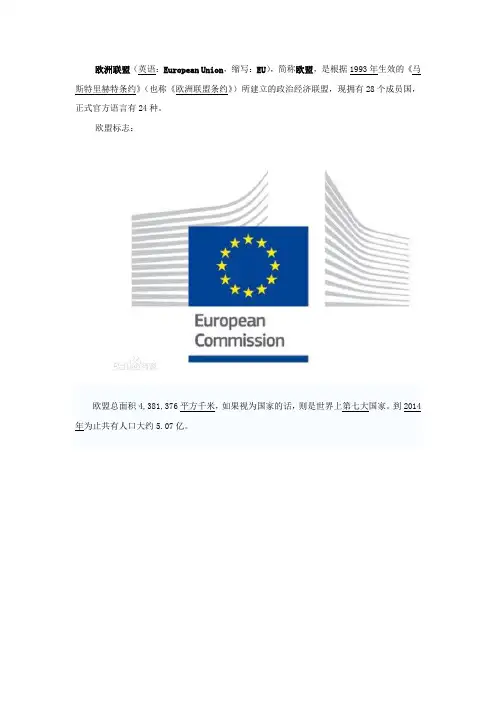

名词解释欧盟的意思欧盟(European Union)作为一个独特的国际组织,在全球范围内具有重要的政治、经济和社会影响力。
它由欧洲各国共同组成,旨在促进成员国之间的合作与协调,以实现共同繁荣、和平与稳定。
欧盟的创建和发展历程曲折,其意义和作用也因其独特性而备受关注。
欧盟的起源可以追溯到20世纪40年代末,当时欧洲大陆在二战的阴霾下陷入一片废墟。
欧洲国家为了摆脱战争带来的伤痛,意识到需要一种全新的合作方式。
1951年,法国、德国、意大利、比利时、荷兰和卢森堡六个国家签署了《巴黎公约》,宣布成立欧洲煤钢共同体,这被视为欧盟的前身。
欧盟的成立并非源于简单的经济考虑,而是出于对战争的恐惧和对和平的追求。
通过将关键资源,如煤炭和钢铁,置于国际合作框架下运作,战争的潜在动因得以根除。
随后,欧盟的发展逐步扩展到经济和社会领域,形成了一个更加综合的合作框架。
欧盟独特之处在于其成员国以主权国家的身份参与其中,但却具有一定的超国家特征。
欧盟的法律和政策适用于所有成员国,它们必须遵守和执行欧盟法规和指令。
此外,欧盟还设有一系列的机构和组织来管理其日常事务,如欧洲委员会、欧洲议会、欧洲理事会等。
欧盟的核心目标是建立一个共同市场,实现欧洲市场的内部一体化。
为了实现这一目标,欧盟国家逐步消除了贸易壁垒,如关税和非关税壁垒,以促进商品、服务、资本和人员的自由流动。
此外,欧盟还通过共同的货币,即欧元,进一步加强成员国之间的经济联系。
除了经济一体化,欧盟还致力于推动其他政策领域的合作。
例如,欧盟在环境保护、农业和渔业、能源和气候变化等方面采取了共同行动,以解决跨国界问题和提高成员国的整体竞争力。
此外,欧盟还在外交政策和安全事务方面进行合作,以共同应对国际挑战。
然而,欧盟也面临着一系列的挑战和批评。
有些人认为,欧盟过于官僚化,决策过程缺乏透明度和民主性,并且给一些成员国带来了不公平的经济负担。
此外,欧盟在应对移民和难民问题、恐怖主义威胁、经济不平等等方面也面临困难。

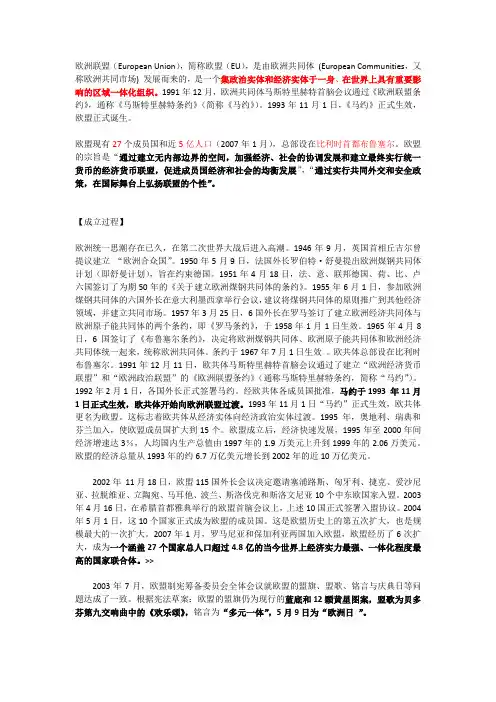
欧洲联盟(European Union),简称欧盟(EU),是由欧洲共同体(European Communities,又称欧洲共同市场) 发展而来的,是一个集政治实体和经济实体于一身、在世界上具有重要影响的区域一体化组织。
1991年12月,欧洲共同体马斯特里赫特首脑会议通过《欧洲联盟条约》,通称《马斯特里赫特条约》(简称《马约》)。
1993年11月1日,《马约》正式生效,欧盟正式诞生。
欧盟现有27个成员国和近5亿人口(2007年1月),总部设在比利时首都布鲁塞尔。
欧盟的宗旨是“通过建立无内部边界的空间,加强经济、社会的协调发展和建立最终实行统一货币的经济货币联盟,促进成员国经济和社会的均衡发展”,“通过实行共同外交和安全政策,在国际舞台上弘扬联盟的个性”。
【成立过程】欧洲统一思潮存在已久,在第二次世界大战后进入高潮。
1946年9月,英国首相丘吉尔曾提议建立“欧洲合众国”。
1950年5月9日,法国外长罗伯特·舒曼提出欧洲煤钢共同体计划(即舒曼计划),旨在约束德国。
1951年4月18日,法、意、联邦德国、荷、比、卢六国签订了为期50年的《关于建立欧洲煤钢共同体的条约》。
1955年6月1日,参加欧洲煤钢共同体的六国外长在意大利墨西拿举行会议,建议将煤钢共同体的原则推广到其他经济领域,并建立共同市场。
1957年3月25日,6国外长在罗马签订了建立欧洲经济共同体与欧洲原子能共同体的两个条约,即《罗马条约》,于1958年1月1日生效。
1965年4月8日,6国签订了《布鲁塞尔条约》,决定将欧洲煤钢共同体、欧洲原子能共同体和欧洲经济共同体统一起来,统称欧洲共同体。
条约于1967年7月1日生效。
欧共体总部设在比利时布鲁塞尔。
1991年12月11日,欧共体马斯特里赫特首脑会议通过了建立“欧洲经济货币联盟”和“欧洲政治联盟”的《欧洲联盟条约》(通称马斯特里赫特条约,简称“马约”)。
1992年2月1日,各国外长正式签署马约。
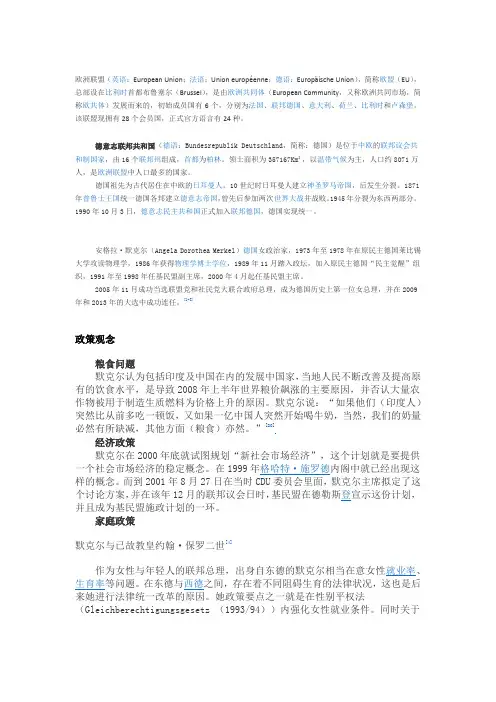
欧洲联盟(英语:European Union;法语:Union européenne;德语:Europäische Union),简称欧盟(EU),总部设在比利时首都布鲁塞尔(Brussel),是由欧洲共同体(European Community,又称欧洲共同市场,简称欧共体)发展而来的,初始成员国有6个,分别为法国、联邦德国、意大利、荷兰、比利时和卢森堡。
该联盟现拥有28个会员国,正式官方语言有24种。
德意志联邦共和国(德语:Bundesrepublik Deutschland,简称:德国)是位于中欧的联邦议会共和制国家,由16个联邦州组成,首都为柏林。
领土面积为357167Km²,以温带气候为主,人口约8071万人,是欧洲联盟中人口最多的国家。
德国祖先为古代居住在中欧的日耳曼人。
10世纪时日耳曼人建立神圣罗马帝国,后发生分裂。
1871年普鲁士王国统一德国各邦建立德意志帝国,曾先后参加两次世界大战并战败。
1945年分裂为东西两部分。
1990年10月3日,德意志民主共和国正式加入联邦德国,德国实现统一。
安格拉·默克尔(Angela Dorothea Merkel)德国女政治家,1973年至1978年在原民主德国莱比锡大学攻读物理学,1986年获得物理学博士学位,1989年11月踏入政坛,加入原民主德国“民主觉醒”组织,1991年至1998年任基民盟副主席,2000年4月起任基民盟主席。
2005年11月成功当选联盟党和社民党大联合政府总理,成为德国历史上第一位女总理,并在2009年和2013年的大选中成功连任。
[1-3]政策观念粮食问题默克尔认为包括印度及中国在内的发展中国家,当地人民不断改善及提高原有的饮食水平,是导致2008年上半年世界粮价飙涨的主要原因,并否认大量农作物被用于制造生质燃料为价格上升的原因。
默克尔说:“如果他们(印度人)突然比从前多吃一顿饭,又如果一亿中国人突然开始喝牛奶,当然,我们的奶量必然有所缺减,其他方面(粮食)亦然。

欧洲联盟名词解释欧洲联盟(European Union,简称EU)是一个由欧洲国家组成的政治经济联盟,其目标是通过推动经济和政治合作,促进和平、稳定和繁荣。
1. 成员国: 欧洲联盟由27个成员国组成,这些国家通过签署欧洲联盟条约并遵守其规定,共同参与欧洲联盟的决策和政策制定。
2. 欧洲联盟条约: 欧洲联盟条约是欧洲联盟的宪法,规定了成员国之间的权力和义务,以及机构的组成和职能。
目前的欧洲联盟条约是《里斯本条约》,于2009年生效。
3. 单一市场: 欧洲联盟的核心目标之一是建立一个自由流动的单一市场,允许货物、人员、服务和资本在成员国之间自由流通。
这促进了经济一体化和增加了贸易和投资机会。
4. 欧元区: 欧元区是指那些使用欧元作为官方货币的欧洲联盟成员国。
这些国家实行相同的货币政策,由欧洲中央银行管理。
5. 欧洲议会: 欧洲议会是欧洲联盟的立法机构,代表欧盟公民的利益。
议会的议员由成员国以比例代表制选举产生,它共同制定和修改欧盟的法律,并对其他机构的决策进行监督。
6. 欧洲委员会: 欧洲委员会是欧洲联盟的行政机构,由27名委员组成,每个国家派出一名委员。
它负责制定欧盟的政策和法规,并实施和监督欧洲联盟的政策措施。
7. 欧洲理事会: 欧洲理事会是由每个成员国的国家元首或政府首脑组成的机构。
它提供欧盟的政治指导并制定战略性的指导方针。
欧洲理事会还负责处理与成员国之间的关系和促进欧盟内的合作。
8. 《里斯本战略》: 《里斯本战略》是欧盟在2000年采取的一项宏伟计划,旨在通过增加欧盟的经济竞争力和创新力,加强社会和环境可持续发展,以及提高就业和社会包容性。
9. 瑞典例外权: 瑞典例外权是指瑞典在加入欧盟时获得的特殊权力,允许其在某些特定领域保留国家主权,而不参与相关的欧盟政策制定和法定规定。
10. 整体性政策: 整体性政策是欧盟的一个特点,其涉及各个领域的政策相互联系和协调。
通过整体性政策,欧盟的目标是在各个政策领域中实现协同效应,以达到更好的结果和效益。
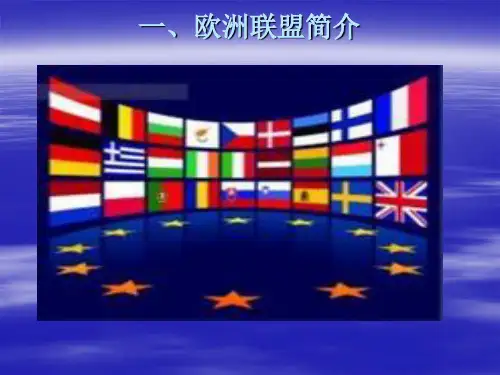
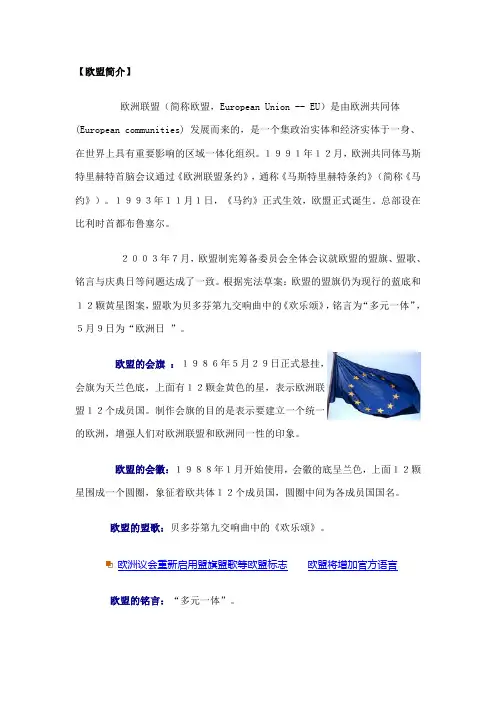
【欧盟简介】欧洲联盟(简称欧盟,European Union -- EU)是由欧洲共同体 (European communities) 发展而来的,是一个集政治实体和经济实体于一身、在世界上具有重要影响的区域一体化组织。
1991年12月,欧洲共同体马斯特里赫特首脑会议通过《欧洲联盟条约》,通称《马斯特里赫特条约》(简称《马约》)。
1993年11月1日,《马约》正式生效,欧盟正式诞生。
总部设在比利时首都布鲁塞尔。
2003年7月,欧盟制宪筹备委员会全体会议就欧盟的盟旗、盟歌、铭言与庆典日等问题达成了一致。
根据宪法草案:欧盟的盟旗仍为现行的蓝底和12颗黄星图案,盟歌为贝多芬第九交响曲中的《欢乐颂》,铭言为“多元一体”,5月9日为“欧洲日”。
欧盟的会旗:1986年5月29日正式悬挂,会旗为天兰色底,上面有12颗金黄色的星,表示欧洲联盟12个成员国。
制作会旗的目的是表示要建立一个统一的欧洲,增强人们对欧洲联盟和欧洲同一性的印象。
欧盟的会徽:1988年1月开始使用,会徽的底呈兰色,上面12颗星围成一个圆圈,象征着欧共体12个成员国,圆圈中间为各成员国国名。
欧盟的盟歌:贝多芬第九交响曲中的《欢乐颂》。
欧洲议会重新启用盟旗盟歌等欧盟标志欧盟将增加官方语言欧盟的铭言:“多元一体”。
欧盟的统一货币:欧元 (euro),1999年1月1月1日零时,欧元正式流通。
截至2009年1月,欧元区成员国有16个。
欧盟的主要出版物:《欧洲联盟公报》、《欧洲联盟月报》、《欧洲文献》、《欧洲新闻—对外关系》和《欧洲经济》等。
【成立过程】1946年9月,英国首相丘吉尔曾提议建立“欧洲合众国”。
1950年5月9日,当时的法国外长罗贝尔·舒曼(1886年-1963年)代表法国政府提出建立欧洲煤钢联营。
这个倡议得到了法、德、意、荷、比、卢6国的响应。
1951年4月18日,法国、联邦德国、意大利、荷兰、比利时和卢森堡在巴黎签订了建立欧洲煤钢共同体条约(又称《巴黎条约》)。
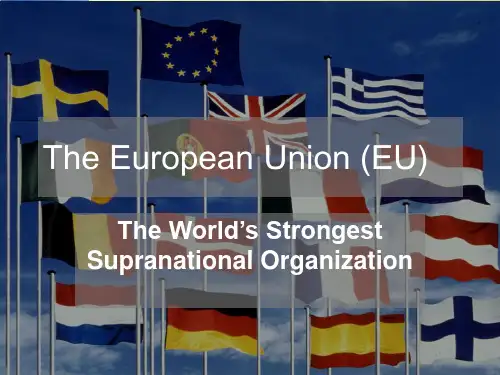

欧盟介绍作文英语版Title: Introduction to the European Union。
Introduction:The European Union (EU) is an economic and political union comprising 27 member states, located primarily in Europe. It traces its origins to the European Coal and Steel Community (ECSC) and the European Economic Community (EEC), formed by six countries in the 1950s. Over the decades, the EU has evolved into a unique entity, playing a significant role in global affairs. This essay aims to provide a comprehensive overview of the European Union, covering its history, institutions, policies, and significance in the contemporary world.History:The roots of the European Union can be traced back to the aftermath of World War II, when European leaders soughtto prevent future conflicts through economic integration. In 1951, the Treaty of Paris established the European Coal and Steel Community, which aimed to unify the coal andsteel industries of its member states. This initiative was followed by the signing of the Treaty of Rome in 1957, which created the European Economic Community and the European Atomic Energy Community. These treaties laid the foundation for what would eventually become the European Union.Institutions:The European Union operates through a complex system of institutions, each with its specific roles and responsibilities. The European Commission, based in Brussels, serves as the executive branch of the EU, responsible for proposing legislation and implementing EU policies. The European Parliament, consisting of directly elected representatives from each member state, acts as the legislative body, debating and voting on proposed laws. The European Council, composed of the heads of state or government of the member states, sets the EU's overallpolitical direction and priorities. Additionally, the Court of Justice of the European Union ensures the uniform interpretation and application of EU law.Policies:The European Union has developed a wide range of policies aimed at promoting economic prosperity, social cohesion, and environmental sustainability. The Common Agricultural Policy (CAP) aims to support farmers and ensure food security across the EU. The Single Market seeks to remove barriers to trade and investment, fostering economic growth and competitiveness. The EU also has policies addressing issues such as climate change, energy security, and migration, reflecting its commitment to tackling global challenges collectively.Significance:The European Union plays a crucial role in shaping the global political and economic landscape. As the world's largest single market, the EU is a major economic power,accounting for a significant share of global GDP and trade. Its common currency, the euro, is used by 19 of its member states, further enhancing its economic influence. Moreover, the EU's commitment to multilateralism and international cooperation has made it a key player in efforts to address global issues such as climate change, terrorism, and nuclear proliferation.Challenges:Despite its achievements, the European Union faces numerous challenges that threaten its unity and effectiveness. Brexit, the withdrawal of the United Kingdom from the EU, has raised questions about the bloc's future and strained relations with one of its largest members. Additionally, the EU grapples with internal divisions over issues such as migration, economic governance, and the rule of law, highlighting the complexities of governing a diverse union of sovereign states.Conclusion:In conclusion, the European Union stands as a remarkable example of regional integration and cooperation. From its humble beginnings as a coal and steel community to its current status as a global actor, the EU has achieved significant progress in promoting peace, prosperity, and solidarity among its member states. However, the challenges it faces underscore the need for continued reform and adaptation to ensure its relevance and effectiveness in the ever-changing world order. As such, the European Union remains a fascinating subject of study and debate for scholars, policymakers, and citizens alike.。
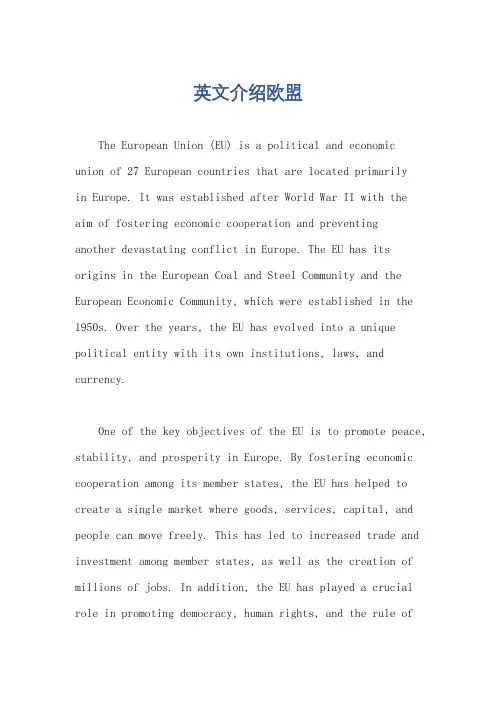
英文介绍欧盟The European Union (EU) is a political and economic union of 27 European countries that are located primarilyin Europe. It was established after World War II with the aim of fostering economic cooperation and preventinganother devastating conflict in Europe. The EU has its origins in the European Coal and Steel Community and the European Economic Community, which were established in the 1950s. Over the years, the EU has evolved into a unique political entity with its own institutions, laws, and currency.One of the key objectives of the EU is to promote peace, stability, and prosperity in Europe. By fostering economic cooperation among its member states, the EU has helped to create a single market where goods, services, capital, and people can move freely. This has led to increased trade and investment among member states, as well as the creation of millions of jobs. In addition, the EU has played a crucial role in promoting democracy, human rights, and the rule oflaw in Europe.The EU has its own institutions, including the European Commission, the European Parliament, the Council of the European Union, and the European Court of Justice. These institutions work together to make decisions on a wide range of issues, such as trade, agriculture, immigration, and the environment. The EU also has its own currency, the euro, which is used by 19 of its member states. The EU's common policies and regulations help to ensure a level playing field for businesses and consumers across Europe.In order to join the EU, a country must meet certain criteria known as the "Copenhagen criteria." These criteria include having a stable democracy, a functioning market economy, and the ability to adopt and implement EU laws and regulations. Once a country meets these criteria, it must negotiate a membership agreement with the EU and undergo a process of accession, which can take several years. Currently, several countries in Europe, such as Albania, North Macedonia, and Serbia, are in the process of seeking EU membership.The EU faces a number of challenges, including Brexit, the rise of populist and nationalist movements in some member states, and the ongoing refugee crisis. Brexit, the UK's decision to leave the EU, has raised questions about the future of the EU and its ability to maintain unity and solidarity among its member states. Populist andnationalist movements in countries such as Hungary, Poland, and Italy have challenged the EU's values of democracy, human rights, and the rule of law. The refugee crisis, which has seen millions of people fleeing conflict and persecution in the Middle East and Africa, has strained the EU's ability to manage migration and asylum policies.Despite these challenges, the EU remains a unique and powerful force for peace, stability, and prosperity in Europe. By working together, its member states can address common challenges and achieve common goals that would be impossible to achieve on their own. The EU's commitment to democracy, human rights, and the rule of law sets it apart as a beacon of hope and progress in an increasingly uncertain world.。
欧盟说明书一、欧盟简介1.组织结构欧盟(European Union,简称EU)起源于1951年的欧洲煤钢共同体,经过多次扩大和发展,现已成为世界上最具影响力的国际组织之一。
欧盟总部位于比利时首都布鲁塞尔,其组织结构主要包括欧洲议会、欧盟委员会、欧洲法院等机构。
2.成员国概况目前,欧盟共有27个成员国,包括德国、法国、英国、意大利等大国,以及一些中小国家。
成员国之间政治制度、经济发展水平、文化传统有所不同,但都在一定程度上实现了政治、经济、社会的整合。
二、欧盟共同政策1.经济政策欧盟在经济领域实施共同政策,如共同市场、共同货币(欧元区)、共同财政政策等。
这些政策旨在促进成员国间的贸易往来,实现资源优化配置,提高整体竞争力。
2.外交与安全政策欧盟在外交和安全领域也采取共同立场,如共同外交政策、共同安全政策、共同防务政策等。
此外,欧盟还积极参与国际事务,推动全球治理体系改革,维护国际和平与安全。
3.环境政策欧盟高度重视环境保护,制定了一系列环境政策,如碳排放交易体系、可再生能源发展目标等。
这些政策旨在实现可持续发展,降低气候变化风险,提高生态环境质量。
4.司法与内政政策在司法领域,欧盟建立了欧洲法院、欧洲检察院等机构,负责审理成员国之间的纠纷,保障欧盟法律的有效实施。
在内政领域,欧盟积极推动成员国在签证、移民、反恐等方面的合作。
三、欧盟与中国的关系1.经贸合作欧盟是中国最大的贸易伙伴,双方在经贸领域保持着紧密的合作关系。
中欧双边投资、贸易往来不断加深,为双方经济发展注入了活力。
2.政治对话欧盟与中国建立了高级别战略对话机制,就重大国际事务保持密切沟通。
双方在人权、西藏等问题上存在分歧,但双方均表示愿通过对话与协商解决问题。
3.文化交流欧盟与中国在文化领域开展了广泛的合作与交流,如举办中欧文化论坛、互派文化团组等。
这些活动增进了双方人民的相互了解与友谊,丰富了中欧关系内涵。
四、欧盟未来发展展望1.一体化进程面对全球挑战,欧盟将继续推进一体化进程,深化成员国在政治、经济、国防等领域的合作。
介绍欧盟英文作文带翻译英文:The European Union, commonly known as the EU, is a political and economic union of 27 member states located primarily in Europe. The EU was established by the Treatyof Maastricht in 1993 and has since grown in size and scope. Its member states share a common currency, the euro, and a single market, which allows for the free movement of goods, services, capital, and people within the EU. The EU alsohas a common foreign and security policy, which aims to promote peace and stability both within and outside the EU.One of the main goals of the EU is to promote economic growth and prosperity for its member states. This is achieved through various policies and programs, such as the European Regional Development Fund, which provides funding for infrastructure projects in less developed regions ofthe EU. The EU also promotes research and innovationthrough programs like Horizon 2020, which provides fundingfor research projects in areas such as health, energy, and the environment.In addition to its economic goals, the EU also aims to promote social justice and human rights. For example, the EU has established the European Social Fund, which provides funding for projects that aim to reduce poverty and promote social inclusion. The EU also has a Charter of Fundamental Rights, which outlines the basic rights and freedoms that all EU citizens are entitled to.Overall, the EU plays a crucial role in promoting cooperation and unity among its member states. By working together, the EU is able to tackle common challenges and achieve common goals, such as promoting economic growth, protecting human rights, and maintaining peace and stability.中文:欧洲联盟,通常称为欧盟,是由27个成员国组成的政治和经济联盟,主要位于欧洲。
Good morning/afternoon/evening. It is a great honor to stand before you today to introduce the European Union, an organization that has profoundly impacted the world we live in.The European Union, often abbreviated as EU, is a political and economic union of 27 member states located primarily in Europe. It wasestablished on November 1, 1993, following the ratification of the Maastricht Treaty. The EU aims to promote peace, stability, and economic growth among its member states, while also ensuring the protection of human rights and the rule of law.The EU has a rich history, dating back to the late 20th century when European countries sought to prevent another devastating war on their continent. The foundation of the EU can be traced back to the European Coal and Steel Community (ECSC) in 1951, which later evolved into the European Economic Community (EEC) and then the European Union.The EU has several key objectives:1. Peace and Stability: The EU was born out of the ashes of World War II. Its primary aim is to foster peace and stability among member states through cooperation and dialogue. The EU has played a crucial role in resolving conflicts and promoting reconciliation in various regions, including the Balkans.2. Economic Growth: The EU aims to promote economic growth andprosperity by eliminating trade barriers and creating a single market. The single market allows the free movement of goods, services, capital, and people within the EU, fostering economic integration and competitiveness.3. Social and Environmental Protection: The EU works to ensure high standards of living and social protection for its citizens. It has introduced policies and regulations to safeguard the environment, promote sustainable development, and combat climate change.4. Human Rights and Rule of Law: The EU upholds the principles of human rights, democracy, and the rule of law. It works to promote these values within its member states and beyond.The EU operates through various institutions, each with its own role and responsibilities:1. The European Parliament: The European Parliament is the EU's main legislative body, representing the citizens of the EU. Members of the European Parliament (MEPs) are elected every five years.2. The European Council: The European Council consists of the heads of state or government of the member states, the President of the European Council, and the President of the European Commission. It sets the EU's overall political direction.3. The European Commission: The European Commission is the EU's executive body, responsible for proposing legislation, implementing decisions, and managing the EU's day-to-day business.4. The European Central Bank: The European Central Bank is responsible for maintaining price stability in the euro area, which is the single currency used by 19 of the 27 member states.5. The Court of Justice of the European Union: The Court of Justice of the European Union ensures that EU law is interpreted and applied consistently across all member states.The EU has faced several challenges over the years, including economic crises, migration issues, and debates over sovereignty and national identity. However, it remains a powerful force for unity and progress in Europe.In conclusion, the European Union is an extraordinary organization that has brought together countries with diverse cultures, languages, and histories. Its achievements in promoting peace, stability, and economic growth are truly remarkable. As we look to the future, the EU will undoubtedly continue to play a vital role in shaping the world we live in.Thank you for your attention.。